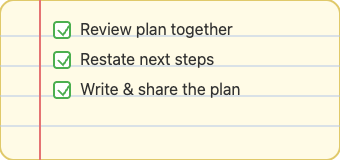When you’re helping two people solve a conflict, your job is to guide them—not to take sides or act like a judge. It’s important to stay neutral, even when one person seems more “right” or “wrong.” Your goal is to help both people keep their promises to each other, not to punish anyone if things don’t go perfectly.
In this lesson, you’ll learn:
- How to maintain neutrality while still supporting accountability
- Help people define clear next steps for resolving their conflict
- Summarize agreements so everyone knows what’s been decided and what still needs attention.
You’ll practice asking helpful questions, keeping the conversation focused on solutions, and making sure everyone feels supported—not blamed.
If someone doesn’t follow through on what they agreed to, don’t jump to blame. Instead, ask questions to understand what happened. For example, instead of saying, “You didn’t do what you promised,” you can say, “I noticed the plan didn’t work out as we hoped. What got in the way?” This helps people feel safe to be honest and keeps the conversation focused on fixing the problem, not on who’s at fault.
Remind everyone that keeping promises is about making things better for both people. You can say, “When you both follow through, it helps you work together with less stress.” If someone is worried about the other person not keeping up, treat it as something to solve together. For example, “Thanks for sharing your concern. Let’s talk about what’s happening and how we can help each other stick to the plan.”
Set up ways for the two people to check in with each other, so you don’t have to be the "referee." Maybe they agree to send each other a quick update once a week, or to meet for five minutes to see how things are going. When people make their own plans to stay on track, they’re more likely to follow through.
If things don’t go as planned, focus on what can be changed. For example, “It looks like the timeline was too tight. What would work better for both of you?” This keeps the conversation positive and solution-focused.
When people agree to fix a problem, it’s important to turn big ideas into small, clear steps. Vague promises like “We’ll communicate better” or “We’ll try harder” usually don’t work, because no one knows exactly what to do. When guiding two people toward shared solutions, help them get specific.
Ask questions like, “What does that look like in real life?” or “How will you know if it’s working?” For example, if two people want to share information better, you can help them decide, “We’ll send each other a short email every Friday with updates.” The more clear and simple the plan, the easier it is to follow.
Here’s how a conversation might go:
- Dan: We need to be better at keeping each other in the loop.
- Victoria: What would that look like?
- Dan: Maybe we could have a quick check-in every Monday morning.
- Victoria: That works for me. How long should it be?
- Dan: Ten minutes should be enough.
- Victoria: Great, let’s try it next week.
Dan and Victoria start with a general goal—improving communication—and work together to create a clear, specific plan: a ten-minute check-in every Monday morning. By asking clarifying questions and agreeing on concrete details, they make it much easier to follow through and stay on track.
It’s also good to check if the plan is realistic. Ask, “Does this feel doable?” or “What might get in the way?” If the plan is too big, help them make it smaller and easier to stick to.
Finally, talk about what to do if things don’t go as planned. For example, “If you can’t make the check-in one week, what should you do?” This helps everyone feel prepared and less stressed if something comes up.
Before ending the conversation, make sure everyone is clear about what they’ve agreed to and what still needs attention. Sometimes people leave a meeting thinking they agreed to different things, which can cause more problems later.
To check for understanding, go over the plan together and ask each person to restate what they will do in their own words. For example, you can say, “Let’s review what you’ve decided so far. Makena, can you share what your next step will be? Cris, how about you?” This helps catch any confusion right away and ensures everyone is on the same page.

It’s also helpful to write down the plan and share it with both people, so they can look back at it later. Remind them that it’s normal for new plans to need some changes. You can say, “Let’s check in after a couple of weeks to see how it’s going and make any tweaks if needed.”
Helping others resolve conflict is about staying neutral, making clear plans, and making sure everyone understands what’s next. By guiding people to create their own solutions and supporting them as they follow through, you help build trust and teamwork. As you practice these skills, you’ll get better at helping others work through problems and create stronger, more positive relationships. Up next, you’ll get a chance to practice these steps in a real-life scenario.
